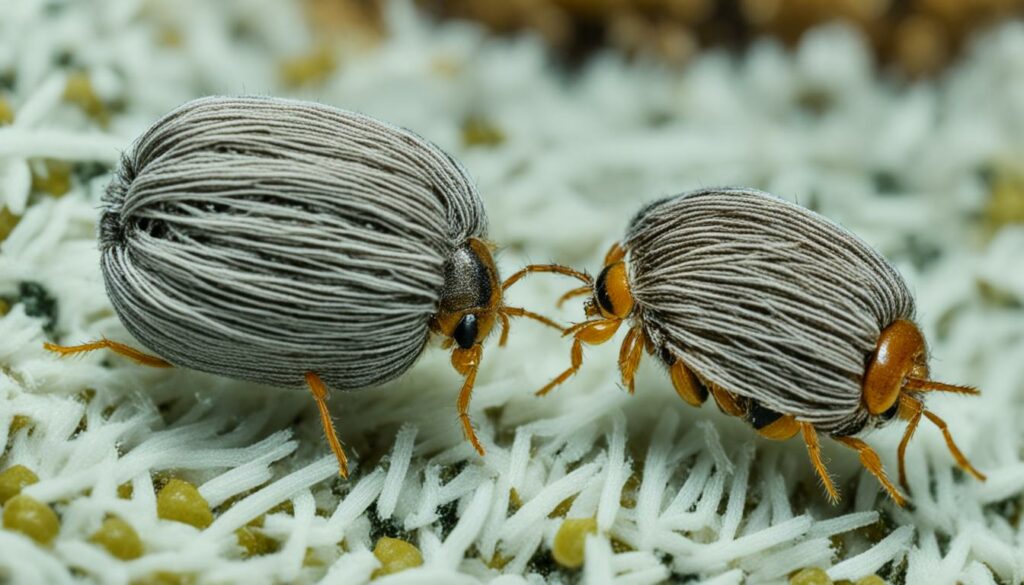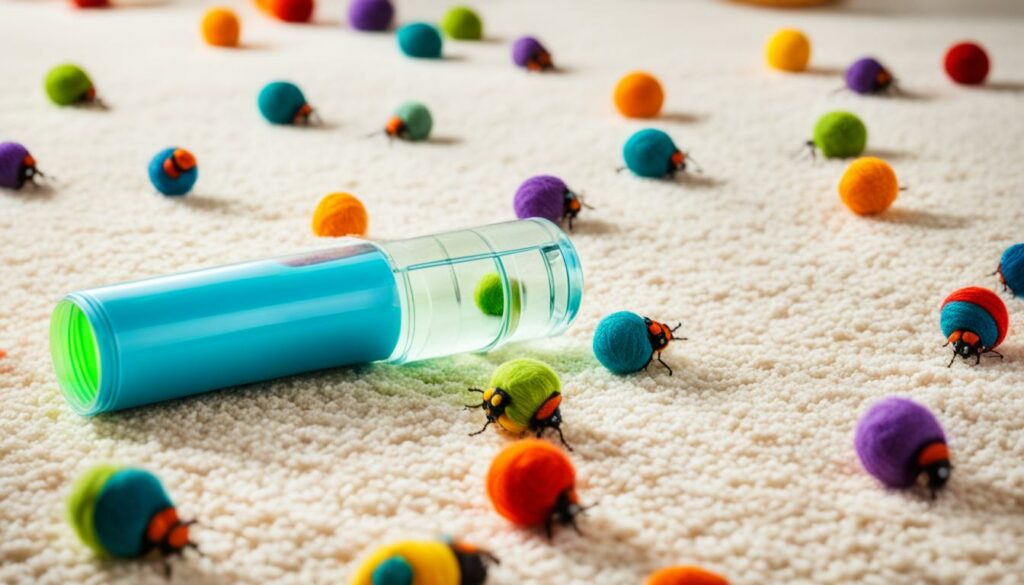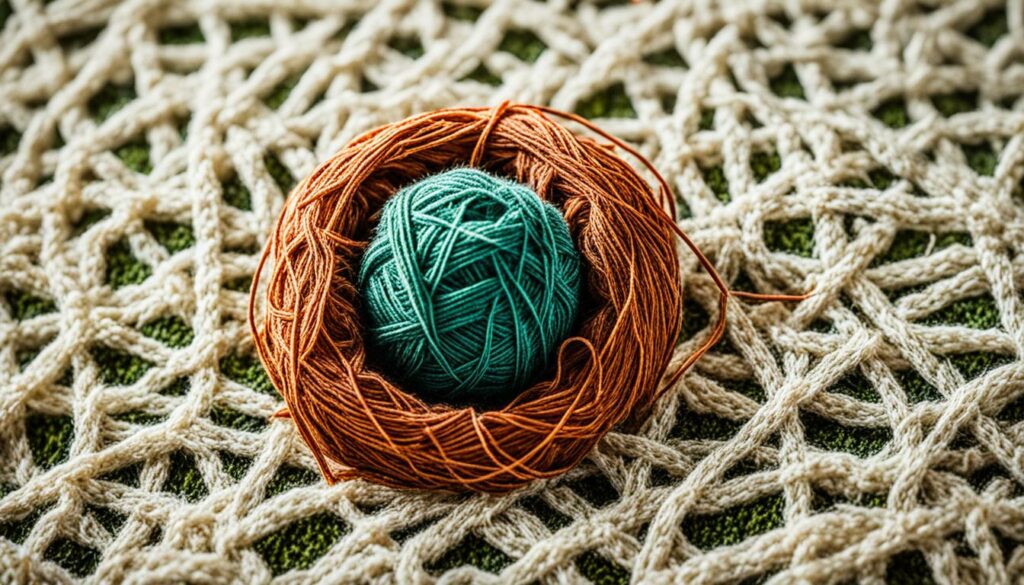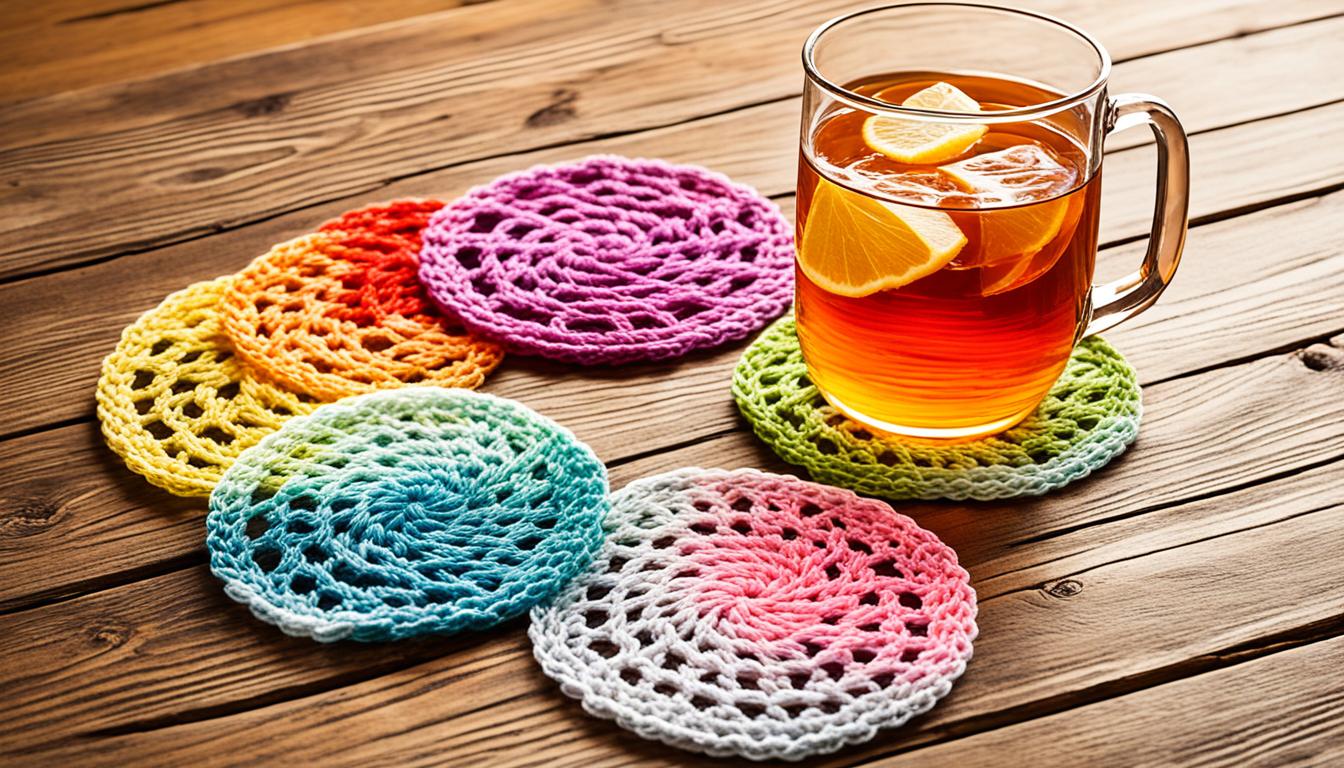When it comes to safeguarding your valuable yarn collection, the last thing you want to be concerned about is pests. However, could your worst fears come true? Do carpet beetles really enjoy feasting on yarn? It’s time to reveal the facts and discover how to protect your yarn stash from these insects that feast on wool.
Key Takeaways:
- Carpet beetles can indeed eat yarn, particularly their voracious larvae.
- Identifying carpet beetle infestations is crucial in preventing further damage to your yarn stash.
- Proactive cleaning and storage practices can help safeguard against carpet beetles.
- Freezing and natural repellents are effective methods for eliminating and deterring these pests.
- Maintaining a clean and organized home can minimize the risk of carpet beetle infestations.
Understanding Carpet Beetle Infestations
Carpet beetles are a common household pest that can cause significant damage to natural fibers, such as wool and silk. Identifying the signs of a carpet beetle infestation is crucial in preventing further damage to your belongings, including your precious yarn stash.
Carpet beetles can be identified by the presence of larvae or adult beetles in your home. The larvae are small, oval-shaped, and covered in hair, while the adult beetles are round and typically have distinctive patterns on their backs. If you notice these pests in your living space, it is important to take immediate action to prevent a full-blown infestation.
Preventing carpet beetle infestations starts with adopting proper cleaning and storage practices. Regularly vacuuming carpets, rugs, and upholstery can help remove any eggs or larvae that may be hiding in these areas. Pay close attention to dark, undisturbed corners and the edges of carpets, as these are common hiding spots for carpet beetle larvae.
When it comes to storing your yarn stash, opt for sealed plastic containers to prevent carpet beetles from accessing your beloved fibers. Avoid using cardboard boxes or open storage bins, as these can provide easy entry points for pests. Additionally, consider placing natural repellents such as lavender sachets or cedar balls in your storage containers to further deter carpet beetles.
“By being proactive and taking preventive measures, you can safeguard your yarn stash from the devastating damage caused by carpet beetle infestations.”
Taking the necessary steps to prevent carpet beetle infestations will not only protect your yarn and other natural fibers but also safeguard the overall condition and cleanliness of your home. By staying vigilant and implementing these preventive measures, you can ensure a pest-free environment for your crafting endeavors.
Tips for Preventing Carpet Beetle Infestations
| Preventive Measures | Description |
|---|---|
| Regular Vacuuming | Vacuum carpets, rugs, and upholstery regularly to remove eggs and larvae. |
| Proper Storage | Store your yarn stash in sealed plastic containers to prevent access by carpet beetles. |
| Natural Repellents | Place lavender sachets or cedar balls in your storage containers to deter carpet beetles. |
| Eliminate Food Sources | Keep your home clean and free from food debris that may attract carpet beetles. |
Carpet Beetle Larvae Diet
The larvae of carpet beetles are notorious for their destructive feeding habits, especially when it comes to natural fibers like wool and silk. These tiny larvae have a versatile diet and will eat through a variety of materials, including your precious yarn stash. Understanding their diet preferences is crucial in protecting your yarn from damage.
Carpet beetle larvae are known to feast on animal fibers, such as wool and silk, which are commonly used in yarn production. They are attracted to the protein present in these fibers and find them highly nutritious. Additionally, these larvae have the ability to consume synthetic fibers, although they offer no nutritional value. So even if your yarn is made of synthetic materials, it is not completely safe from their appetite.
Apart from animal and synthetic fibers, carpet beetle larvae can also target other natural materials in your home, such as feathers, fur, leather, and even certain food items. They’re opportunistic feeders and will feast on anything that provides sustenance. This versatility makes them a significant threat to your yarn collection.
To effectively protect your yarn stash from carpet beetle larvae, it is essential to take preventive measures. Keep your yarn stored in airtight containers or sealed plastic bags to create a barrier between the larvae and your precious fibers. Additionally, maintaining a clean and organized storage area will reduce the likelihood of infestation and minimize potential damage.

Tips for Safeguarding Against Carpet Beetles
To safeguard your yarn stash against carpet beetles, there are several preventive measures you can take. Follow these tips to ensure effective yarn pest control and prevent carpet beetle infestation:
- Step up your cleaning efforts: Regularly vacuum your carpets, rugs, and upholstery to remove any potential food sources for carpet beetles. Pay special attention to areas where pet hair, lint, or crumbs may accumulate.
- Store items in plastic containers: Place your yarn and textile items in sealed plastic containers to prevent carpet beetle infestation. This creates a barrier between the pests and your precious stash, keeping them safe from damage.
- Hire a professional exterminator: If you’re dealing with a persistent carpet beetle infestation, it may be necessary to seek professional help. A licensed exterminator can assess the situation, provide targeted pest control treatments, and offer guidance on long-term prevention.
- Regularly inspect your belongings: Take the time to inspect your yarn, textiles, and storage areas for any signs of carpet beetles or their larvae. Look for shed skins, fecal pellets, or small holes in fabrics, which are indicators of an infestation.
By implementing these preventive measures, you can significantly reduce the risk of a carpet beetle infestation and protect your yarn stash from being damaged. Remember to stay vigilant and take immediate action at the first sign of any pest activity.

Additional Tips:
Properly seal any cracks or openings in your home’s structure to prevent carpet beetles from entering. Inspect doors, windows, and other potential entry points regularly.
Consider using natural repellents like lavender sachets or cedar chips in your yarn storage containers to help deter carpet beetles.
Avoid storing your yarn in dark, damp, or humid areas, as these conditions can attract carpet beetles.
If you handle yarn or textile items that may have come into contact with carpet beetles, wash your hands thoroughly afterwards to minimize the risk of spreading any potential infestation.
By following these tips and maintaining good cleaning and storage practices, you can enjoy your yarn projects without the worry of a carpet beetle infestation.
Identifying and Treating Carpet Beetle Infestations
When it comes to protecting your yarn stash, it is crucial to be able to identify the signs of a carpet beetle infestation. By recognizing the presence of carpet beetle larvae, adult beetles, or damage to fabrics, you can take swift action to address the problem.
If you suspect a carpet beetle infestation, it is recommended to keep a few specimens for proper identification by a pest control professional. This step is essential because carpet beetles have a distinct appearance, and correctly identifying them will ensure effective treatment.
Once you have confirmed a carpet beetle infestation, the next step is to initiate treatment. This typically involves a combination of professional pest control treatments and thorough cleaning and storage practices to eliminate all stages of the carpet beetle life cycle. Professional pest control services can provide specialized treatment options for your home, ensuring comprehensive eradication of these pesky pests.
Alongside professional treatments, implementing cleaning and storage practices is crucial for long-term prevention of carpet beetle infestations and protecting your yarn stash. Regularly vacuuming carpets, rugs, and upholstery can remove any eggs or larvae. Pay extra attention to areas where carpet beetles are likely to hide, such as dark corners or under furniture.
Additionally, washing or dry cleaning infested items can help eliminate carpet beetle larvae and eggs. Ensure that textiles are thoroughly cleaned before storage to prevent any remaining pests from damaging your yarn collection.
Proper identification and swift treatment are key to managing a carpet beetle infestation. By working with a professional pest control service and implementing effective cleaning and storage practices, you can protect your yarn stash from further damage.
Treating Carpet Beetle Infestations: Best Practices
When treating a carpet beetle infestation, it is essential to follow these best practices:
- Consult with a pest control professional for accurate identification and targeted treatment.
- Vacuum regularly, paying attention to areas where carpet beetles may hide.
- Wash or dry clean infested textiles to eliminate larvae and eggs.
- Properly store cleaned items in sealed containers to prevent reinfestation.
- Consider using natural repellents, such as lavender or cedar, to deter carpet beetles from entering your home.
By taking these steps, you can effectively identify and treat carpet beetle infestations, safeguarding your yarn stash and ensuring that your crafting materials remain free from damage.
Cleaning and Laundering Techniques for Infested Items
If you discover carpet beetles or larvae in your yarn or other textile items, it is crucial to take immediate action to prevent further damage and infestation. Here are some effective cleaning and laundering techniques you can use to control yarn pests and prevent carpet beetle infestation:
Bagging and Freezing Method
If you spot any signs of carpet beetles or larvae in your yarn, start by isolating the infested items. Place them in a plastic bag and seal it tightly to prevent the pests from spreading. Then, place the bag in the freezer for at least three days. Freezing the infested items will kill any existing carpet beetles or larvae, effectively eliminating the infestation. Afterward, remove the items from the freezer, allow them to thaw, and check for any remaining signs of infestation.
Hot Dryer Cycle for Washable Items
If you find that your yarn or other textile items are washable, running them through a hot dryer cycle can also help eliminate carpet beetle infestations. The high temperatures will kill the pests and their eggs, effectively halting the infestation. Make sure to follow the care instructions on the yarn label or consult a professional if you are unsure about the appropriate temperature settings for your specific items.
Dry Cleaning for Delicate or Non-Washable Items
If you have delicate or non-washable items that are infested with carpet beetles, dry cleaning may be necessary. Take the infested items to a professional dry cleaner who has experience in dealing with textile pest infestations. They will use specialized cleaning techniques and products to eliminate the pests effectively without causing any damage to the items.
Regular Cleaning and Maintenance
Preventing reinfestation is crucial after addressing a carpet beetle infestation in your yarn stash. Establish a regular cleaning routine for your storage areas, vacuuming and dusting regularly to remove any potential food sources for carpet beetles. It’s also important to inspect your yarn and textile items periodically for signs of infestation. Taking proactive measures like keeping your storage areas clean and well-organized can help prevent future infestations and protect your yarn collection.
By employing these cleaning and laundering techniques, you can effectively control yarn pests and prevent further carpet beetle infestations. Being diligent with your cleaning and maintenance practices will help ensure that your yarn stash remains pest-free and in excellent condition for your crafting projects.

Dealing with Infested Items
In cases where infested items cannot be salvaged or treated, it may be necessary to dispose of them to prevent further spread of the infestation. Identifying carpet beetle damage is crucial in determining the severity of the infestation and the potential damage to your belongings. If you notice irregular holes or damaged fibers in your yarn or textile items, it is likely a result of carpet beetles feeding on the natural fibers.
Proper Disposal and Reduction of Infestation
When dealing with severe infestations or irreparably damaged items, it is important to properly dispose of the infested materials. Seal the infested items in a plastic bag and discard them in an outside trash bin to prevent any remaining beetles or larvae from spreading within your home. Preventing carpet beetle infestation is key to avoiding future damage. Removing clutter and excess textile items from your home can help reduce the likelihood of future infestations.
“Properly storing your yarn stash can further protect it from carpet beetles and other pests.”

Storing and Organizing Your Yarn Stash
To safeguard your yarn stash from carpet beetles, it is essential to adopt proper storage practices. Use sealed plastic containers with tight-fitting lids to store your yarn and textile items. This prevents carpet beetles from accessing and infesting your precious materials. Remember to inspect your yarn regularly for any signs of infestation. If you detect carpet beetles or damage, take immediate action to prevent the spread to other items in your stash.
Taking Preventive Measures
- Vacuum your living spaces regularly, paying extra attention to areas where textiles are stored.
- Regularly launder or dry clean clothing and bedding made with natural fibers.
- Ensure your home is well-ventilated to discourage carpet beetles from settling.
- Consider adding natural repellents, such as lavender or cloves, to your storage containers as additional protection.
By following these measures, you can prevent carpet beetle infestation and preserve the integrity of your yarn stash for years to come.
Natural Repellents for Carpet Beetles
When it comes to preventing carpet beetle infestations in your yarn stash, natural repellents can be a useful tool. These repellents work by deterring carpet beetles from entering your storage containers or infesting your precious yarn collection. Here are a few natural repellents that can help protect your yarn:
Lavender and Cloves

Carpet beetles are repelled by strong scents, which makes lavender and cloves excellent choices for keeping them away from your yarn. You can use dried lavender or clove sachets and place them inside your storage containers or near your yarn stash. The pleasant aroma of lavender and cloves will not only deter carpet beetles but also give your yarn a delightful fragrance.
Cedar Chips or Balls
Another natural repellent that works well against carpet beetles is cedar. The strong scent of cedar is disliked by these pests, making it an effective deterrent. You can place cedar chips or balls in your storage containers or yarn drawers to keep carpet beetles at bay. Not only will the cedar scent repel these pests, but it will also add a fresh and natural aroma to your yarn collection.
By incorporating these natural repellents into your yarn storage routine, you can add an extra layer of protection against carpet beetle infestations. Remember to regularly replenish the repellents to ensure their effectiveness. With these simple measures, you can keep your yarn safe and free from the damage caused by carpet beetles.
Freezing as a Treatment Method
When it comes to tackling wool-eating insects and ensuring effective yarn pest control, freezing is an economical and efficient treatment method. By utilizing freezing temperatures, you can eliminate carpet beetles and their larvae that may be infesting your precious yarn stash. Placing infested yarn or fabrics in a freezer at temperatures below 0 degrees Fahrenheit for a minimum of three days is the key to success.
Freezing works by subjecting the pests to extremely cold temperatures, effectively killing them and preventing further damage to your yarn. This method is particularly beneficial as a cost-effective alternative to pricier options like dry cleaning or professional extermination services.
According to textile experts, freezing is a recommended treatment for wool-eating insects like carpet beetles and their larvae. By freezing infested items, you can ensure the complete eradication of pests while minimizing potential harm to your yarn.
Implementation Guide
To utilize freezing as a treatment method for wool-eating insects, follow these simple steps:
- Gather the infested yarn or fabrics that you suspect may be hosting carpet beetles or their larvae.
- Ensure that the items are clean and dry before proceeding with the freezing process.
- Place the yarn or fabrics in sealed plastic bags to protect them from moisture during freezing.
- Label the bags with the date of freezing to keep track of the treatment duration.
- Put the bags in your freezer, ensuring a temperature of below 0 degrees Fahrenheit.
- Leave the infested items in the freezer for a minimum of three days to guarantee the elimination of pests.
- After the designated freezing period, remove the bags from the freezer.
- Thaw the items at room temperature and inspect them for any signs of remaining pests.
- If necessary, repeat the freezing process until you are confident all wool-eating insects are eliminated.
By diligently following these steps, you can effectively employ freezing as a treatment method, ensuring the protection of your yarn from the damage caused by carpet beetles and their larvae.
| Benefits of Freezing as a Treatment Method | Considerations |
|---|---|
|
|
Remember, freezing is just one aspect of comprehensive yarn pest control. It’s crucial to adopt preventive measures, such as regular cleaning, proper storage in sealed containers, and using natural repellents, to minimize the risk of future infestations. By implementing these strategies, you can ensure the long-lasting protection and enjoyment of your cherished yarn collection.

Cleaning and Maintaining a Carpet Beetle-Free Home
Maintaining a clean and organized home is essential in preventing carpet beetle infestations. By following a few key cleaning and maintenance practices, you can significantly reduce the risk of these pests damaging your precious yarn stash. Here are some tips to help you keep your home carpet beetle-free:
Regular Vacuuming
Prevent carpet beetle infestation by regularly vacuuming carpets, upholstery, and hard-to-reach areas. These hidden spots are often overlooked but can harbor potential food sources for carpet beetles, including pet hair, dust, and skin flakes. Be sure to use a vacuum cleaner with a powerful suction and consider using a nozzle attachment for reaching crevices and corners.

Laundering and Storing Textiles Properly
Yarn pest control starts with proper laundering and storage techniques. When washing your textiles, follow the manufacturer’s instructions for the appropriate water temperature and cycle. Hot water and high heat from the dryer can help eliminate any potential larvae or eggs that may be present. Additionally, store your yarn and other textile items in sealed plastic containers or bags to prevent any future infestation.
Minimize Clutter
Clearing clutter from your home not only creates a neat and organized space but also reduces the likelihood of carpet beetle infestations. Piles of clothing, fabrics, and other textile items provide ideal hiding places for these pests. Regularly declutter your living areas and consider donating or discarding items that are no longer needed. A tidy home is less welcoming to carpet beetles.
Inspect and Take Prompt Action
To effectively prevent carpet beetle infestations, regularly inspect your yarn stash and other textile items for any signs of damage or pests. Keep an eye out for larvae, beetles, or small holes in fabrics, as these are indications of an ongoing infestation. If you notice any signs, take prompt action by isolating the affected items, laundering or freezing them, and consulting with a pest control professional if necessary.
Natural Repellents
As an additional measure, you can use natural repellents to deter carpet beetles. Consider placing sachets filled with strong-smelling herbs like lavender or cloves in your yarn storage areas. The overpowering scent can repel these pests and provide an extra layer of protection for your precious yarn collection.
By implementing these preventative measures and adopting good cleaning and maintenance habits, you can minimize the risk of carpet beetle infestations and ensure that your yarn remains safe and pest-free.
Conclusion
Preventing carpet beetle infestation and protecting your yarn stash requires a proactive approach to cleaning, storage, and pest control. By staying vigilant for the early signs of infestation, you can take swift action to safeguard your precious yarn collection from these wool-eating insects.
Regular inspections of your yarn stash and surrounding areas can help identify any potential infestations before they worsen. Implementing effective cleaning practices, such as vacuuming regularly and laundering textiles thoroughly, removes potential food sources for carpet beetles.
In addition, incorporating natural repellents, like strong-smelling herbs or cedar, into your storage containers can act as a deterrent against carpet beetles. These measures, coupled with freezing infested items for at least three days, can help control and eliminate these pests without the need for professional interventions.
By following these preventive measures and maintaining a clean and organized home, you can enjoy a pest-free yarn stash and continue your crafting endeavors with peace of mind. Don’t let carpet beetles ruin your precious creations – take action today to keep your yarn safe and free from infestation.









